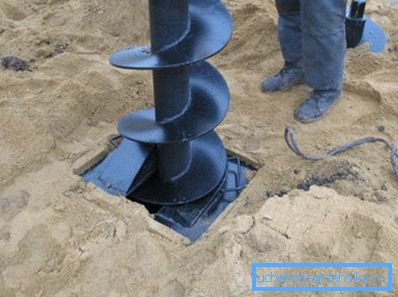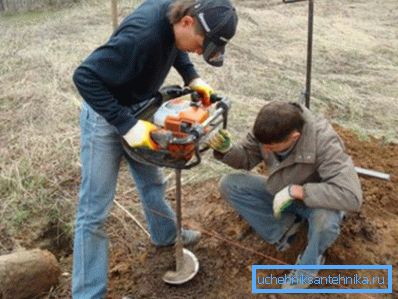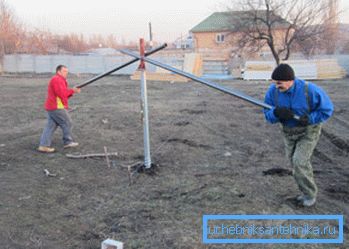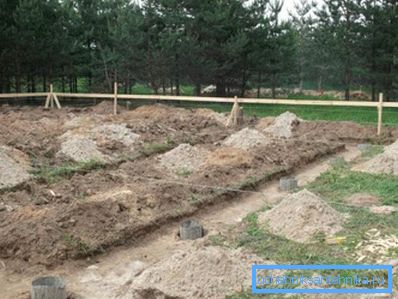How is drilling under the foundation
Building a foundation for different objects is an important and crucial stage. From its quality depends on the life of the building. Therefore, before starting the process, it is necessary to carry out the relevant preparatory work.
At the first stage it is necessary to investigate the soil on the site. These results will answer the question of what type of foundation is best to apply here.

Often, individual developers begin construction work with a complex, loose and heaving ground. Its peculiarity is mobility, which does not allow the installation of certain types of foundations, in particular strip.
The main goal in this case is the possibility of reaching the fixed layers under the ground. The best option for this is the manufacture of a pile filler base, for which it is necessary to drill wells.

Features of the pile foundation
This type of foundation has been widely used in industrial and civil construction. If it is compared with other variants of the foundation, this technology will be less labor-intensive and more economical.
The reasons for choosing this type of base are often due to the following factors:
- Soil on the site with a weak top layer. Soils of this type:
- sandy-clay soils, which are often highly saturated with water;
- loam and clay - in a plastic state;
- vegetative soil in which there is humus or peat.
In this case, it is necessary to transfer the load of the building to the dense layers of soil, which can be reached only by drilling wells and installing piles in them.
- When planning the construction of a wooden house or light construction, there are no special requirements for the bearing capacity of the foundation. Here the technology makes it possible to significantly reduce the allotted time for construction, will reduce the volume of earthworks, having a significant economic effect on the project budget.
Advantages of pile foundations:
- the base rests on the ground below the freezing level, this significantly affects the stability of the building;
- work on the foundation can be conducted all year round and even stop for a certain period;
- attraction of special equipment is not required;
- the bearing capacity of the base is increased due to the support on the solid soil layer
- concrete consumption is minimal;
- reduces total housing costs for heat;
- reduces the level of vibrations.
The disadvantage, with all the advantages of this foundation, is the impossibility of its device on soils having horizontal movement.
Tip: to understand what type of soil you have on the site, contact a specialist who will make its analysis and provide the result of the study.

When using this technology, it is impossible to make a warm basement or ground floor due to the grillage elevated above the ground. If you decide to fill the space between the supports with something, the price of this arrangement will easily be equal in value to the installation of the foundation itself.
Technology of drilling wells under the foundation
Below is the main sequence of work of this method:
- Payment.
- Drawing scheme of the construction site and placing it on piles.
- Preparatory work on the site.
- Drilling wells, making the frame and the device shells for piles.
- Filling wells with concrete solution.
- Installation grillage.
Training
Traditionally, such construction should be accompanied by a large number of special equipment, but this option for country construction will not always be acceptable. Therefore, very often drilling at the site is done by hand, having first understood the technology and prepared the necessary materials and tools.

You will need:
- fittings;
- rope;
- pegs;
- shovel;
- hand drill or motor drill;
- construction hydro level;
- formwork material;
- ruberoid;
- nails;
- concrete.
Before you begin the process of drilling wells under the piles, carry out the necessary calculations, where you consider the following factors:
- characteristics of the territory;
- soil freezing level;
- soil features on the site;
- groundwater table and seasonal variations;
- wind loads;
- mass of the structure.
Only after that you can begin to prepare the plot, for which make the marking of the territory, using the pegs and rope. At this stage, use the help of a partner to speed up the process. Then mark the places where you will install the piles.

Process
At the next stage, it is necessary to drill wells and fix the piles with a concrete solution. In this case, you can use a mechanical drill or manual.
Proposed instructions for the manufacture of the base on piles:
- Make wells at the marked points. Their shape must be strictly cylindrical. At the bottom it should be expanded for more reliable fastening of the pile.
- Fill the bottom with concrete solution.
- Prepare the formwork by making a pipe of roofing material along the diameter of the well. It should protrude 200-300 mm above the surface. Lower it inwards and pull the top slightly off with a wire.
- Make a reinforcement cage. For it will fit 3 rods O 6 mm, which must be secured to each other with transverse rods with a pitch of 500-600 mm. Insert the frame into the well.

- Fill the structure with concrete, which will contain crushed stone or quartz sand. Fill without interruption, compacting the concrete every 400-600 mm.
Tip: pump out water from a well if its level exceeds 25% of the depth.
Conclusion
The choice of the type of foundation must be left to specialists. The use of piles largely reduces construction time and financial expenses. In the presented video in this article you will find additional information on this topic.